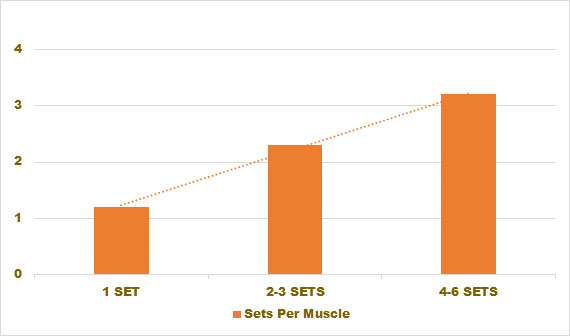With TRX suspension trainer being at hand, many fitness enthusiasts ask, how can we use this tool for optimum muscle growth? Thus, we decide to explore the most functional hypertrophy sets and reps for muscle growth.
Although we can use the TRX trainer for muscle gain, unless we abide by the rules of hypertrophy in the body, we will not see the desired outcome. Hypertrophy is the process of gaining muscle mass and subsequently power and strength. TRX hypertrophy program follows the same principles of hypertrophy at gym.
Table of Contents
Definition of Hypertrophy Sets
During strength training, small muscle fibers, which are called myelin, undergo microscopic tears. After the exercise through the resting period, the body repairs these tiny tears. Gradually, by continuous tears and repair, the muscle grows bigger. This process is called hypertrophy.
Note, in hypertrophy, the size of the fibers increases and not the number of muscle cells. This means training with hypertrophy sets does not produce new muscle cells.
According to the hypertrophy definition, we can conclude the following determining factors in hypertrophy with bodyweight:
- The strain on the muscle should be enough to damage muscle fibers. Hence, we shall not expect noticeable muscle gain if the amount of pressure does not suit multiple hypertrophy sets definition.
- Muscle growth happens during the repair phase after the damage phase. As a result, enough sleep, proper nutrition and post workout recovery play a major role in the rebuilding process.
- Gaining muscle mass is an ongoing process that does not take place overnight. We shall not expect a noticeable change after one or few raining sessions.
Apart from the above points, body structure, genetic, age and hormonal condition of the body play important roles in developing muscle mass.
How Many Times Should I Workout a Week to Gain Muscle?
A study shows that major muscle groups should be trained at least twice a week for optimum hypertrophy.
However, these recommendations should not be considered as being written in stone. According to your schedule and fitness level, you can try one of the following plans for TRX training.
| Beginner | 2 days per week. Each session is a full-body TRX training |
| Advanced | 3 or 4 days per week. Split workout program as per different muscle groups |
In case of 3 sessions per week, schedule your TRX hypertrophy program on alternative days, with rest or cardio days in between.
| Day | Body part |
| Monday | Upper body 1 |
| Tuesday | Rest or Cardio |
| Wednesday | Upper body 2 |
| Thursday | Rest or Cardio |
| Friday | Lower body |
| Saturday | Rest or Cardio |
| Sunday | Rest or Cardio |
For 4 days of TRX suspension training with the aim of gaining muscle, the following schedule is recommended.
| Day | Body part |
| Monday | Upper body 1 |
| Tuesday | Lower body |
| Wednesday | Rest or cardio |
| Thursday | Upper body 2 |
| Friday | Lower body and core |
| Saturday | Rest or Cardio |
| Sunday | Rest or Cardio |
Note that the above schedules are only recommendations. There can be numerous other plans as per one’s goal and fitness level.
How Much Rest Between Hypertrophy Sets?
Intervals between hypertrophy sets are important for muscle recovery. Another review indicates that 1 to 2 minutes of rest between sets is sufficient for best results. It also shows that shorter hypertrophy rest time is more productive than longer times.
However, the rest intervals for hypertrophy should be adjusted according to personal physiological features rather than relying on a predefined precise time. Over time, advanced and experienced athletes can gauge how much rest between hypertrophy sets is suitable by listening to their own bodies.
In comparison between calisthenics and weight training, calisthenics, and in particular TRX trainer system, has more adaptability. We can quickly switch from one exercise to another and adjust the amount of resistance between hypertrophy sets in no time. This feature allows us to efficiently use the rest between sets for hypertrophy, drink some water and start the next hypertrophy set without wasting time.
How Many Sets Per Muscle Group for Hypertrophy?
According to a study, there is a meaningful relationship between the number of hypertrophy sets and acquired muscle mass. In a way that multiple sets bring about a higher percentage of muscle growth than 1 set. Performing 4-6 sets compared to 1 set on a muscle during an exercise session led to a significant increase in muscle mass.

Nevertheless, there is a limit to the amount of muscle growth in a workout session. Straining muscle beyond that limit will put the muscle growth into reverse.
Further analysis shows that there is a limit to the number of sets you can do in a single exercise session before the declining trend of hypertrophy sets starts. Beyond this threshold is called “junk volume”.
According to the researcher James Krieger who had done a deeper investigation on the previous study, approximately after 10 hypertrophy sets on a muscle in a workout session, the decline phase of the exercise begins. Moreover, it increases the recovery time needed for post-workout.
This study also indicates that if you train certain muscle groups every day, this will not result in maximum muscle gain. In fact, this is the mistake many bodyweight training practitioners make. Doing TRX chest press or pull up on a daily basis is not the optimal training volume for hypertrophy.
Find Your Optimal Volume for Hypertrophy Sets
Even so, the fact should be considered that as for training volume for hypertrophy, an exact number cannot be prescribed to everyone. Each person has unique physiological characteristics. Scientific researches should be considered as a compass in planning the best sets for hypertrophy. Within that minimum-maximum hypertrophy set range, which is provided by research, we should fine-tune the training program based on experience and evaluate how our body responds. For most beginners and intermediate fitness enthusiasts, 3 or 4 sets of hypertrophy training per muscle group per exercise suit well in the training program.
Optimal Training Frequency for Muscle Growth
Practicing once or twice a week on each muscle group is usual for muscle hypertrophy sets. This varies as per goal and fitness level. For intermediate athletes, one session per muscle group per week will do the work.
Volume vs. Frequency for Mass
Assuming that you decide to do 5 different exercises on a muscle group like chest and for each exercise do 4 hypertrophy sets, totally, you are doing 20 sets on chest muscles in a single session. This is a high training volume and can be a junk volume. Instead, split this chest workout into two separate sessions. Each session will have 10 hypertrophy sets.
A study investigated the frequency of hypertrophy sets per week per muscle group. During 8 weeks of investigation on the 1 day versus 2 days training frequency for hypertrophy, they found slightly better results with 2 sessions per week.
The split program is particularly useful for more advanced athletes who would like to increase their workout volume on a particular muscle group. Instead of adding to the hypertrophy sets in a single session, increase the frequency of training that muscle group in a week.
Pull Push Workout Plan with Hypertrophy Sets
Push and pull workout program is a type of split exercise that divides muscle groups into two categories of pushing and pulling. In this type of split exercise, pulling muscles of the same body part will be trained one day and pushing muscles another day; it can be the next day or after a rest day.
For upper body pushing and pulling muscles are:
- Pushing muscles: chest muscles, triceps, and shoulders
- Pulling muscles: biceps, back muscles, and forearms
Push and pull training plan is suitable for increasing the volume and frequency of hypertrophy sets on a particular muscle group. It also provides suitable recovery times between training sessions and hence enhances the quality of the training.
A Push Pull Workout Plan with TRX for Muscle Gain:

Push day:
- TRX chest press
- TRX shoulder press
- TRX triceps press
Pull day:
- TRX biceps curl
- TRX pull up
- TRX row
Related, best diy suspension trainer.
Benefit of Calisthenics Push Pull Routine
Traditional bodybuilders train each body part on a separate day. For example, on the first day, they do hypertrophy sets on the chest, on the second day arms, the third day shoulders, and so on. This means that they actually train portions of the same muscle group throughout the week on different days. So, there is a possibility of junk volume and insufficient post workout recovery.
Although the purpose of splitting hypertrophy sets per muscle group per session is targeting each muscle to its full potential, in practice we train other muscle groups along with that targeted group as well. For example, shoulder press engages upper chest muscles as well, or doing chest press strains the triceps too.
This is even more noticeable in bodyweight exercises that naturally engage multiple muscle groups during any exercise. Thus, bodyweight ppl routine has even greater significance when it comes to gaining muscle mass.
Seventy-two hours is sufficient for a full post-workout recovery before another training session on that muscle again. So, the pull and push workout plan allows training each muscle group two times a week with enough gap between two training sessions for recovery.
Push Pull Training Plan for Different Fitness Levels
Beginners with less than six months of experience are better to practice alternative days, three days a week and with one rest day in between sessions.
- Push, upper body muscles
- Rest
- Pull, upper body muscles
- Rest
- Core and leg muscles
Intermediate and advanced athletes can train up to 6 days a week and split hypertrophy sets to push and pull with a rest day in between.
- Push, upper body muscles
- Pull, upper body muscles
- Leg and core muscles
- Rest day
- Push, upper body muscles
- Pull, upper body muscles
- Leg and core muscles
There can be numerous other variations of push pull split plan based on goal and athletic experience.
A ppl bodyweight routine improves post-workout recovery and muscle growth. Everyone at any athletic level can benefit from it.
Isolation Exercises and Compound Exercises with Hypertrophy Sets
- Compound exercises: compound exercises are multi-joint exercises that engage several muscle groups simultaneously. TRX chest press, squat and deadlift are examples of compound exercises. In squat, hamstring muscles, quads muscles, glues, and calves are engaged.
- Isolation exercises: isolation exercises focus on a specific muscle group, such as TRX bicep curl that targets biceps mostly.
Compound exercises usually target large muscle groups, and they should be trained earlier than smaller muscles. At the beginning of the workout session, their fatigue level is lower and the body is prepared to exert maximum energy. Starting hypertrophy sets with compound exercises allows better training quality on large muscles than postponing them after isolation exercises.
On the other hand, following a push-pull training plan, when you start your exercise with large muscles, you are also indirectly training those small muscles and warming them up for the main isolation exercise.
For example, while starting your TRX hypertrophy sets with TRX pull-up, you are indirectly working on the biceps too, and preparing them for the isolation exercise. Likewise, for pushing exercises such as TRX push up, shoulders press, and triceps extension. When you start hypertrophy sets with chest exercise, you are actually warming up shoulders and triceps as well.
Compound exercises increase the amount of testosterone produced in the body, because they engage more muscles and stimulate production of hypertrophy hormone. Hence, they are helpful for the overall muscle growth.
Calisthenics Rep Range for Hypertrophy Sets
Different rep ranges for calisthenics bring about different results. Calisthenics rep range for muscle growth is between 6-12 repetitions. Using more of the body weight with calisthenics repetition range below 6 enhances muscle strength. Calisthenics rep range from 12-15+ with less resistance improves endurance.

So, in order to improve muscle hypertrophy, the amount of pressure should be adjusted in a way that between 6 and 12 repetitions the muscle reaches the state of failure. Practicing TRX for muscle gain, we should adjust the angle of the body to reach muscle failure in that range.
Strength is the maximum amount of force that a muscle exerts in a single contraction. The calisthenics rep range for strength is up to 6 repetitions. It means if you are training bicep curl with TRX trainer and your goal is to activate muscle fibers to their full power, you should adjust the amount of resistance on the muscle so that at 6s repetition you reach failure.
Endurance is the ability to endure muscular fatigue against lower external resistance. Marathon runners are amongst endurance athletes. The calisthenics rep range for endurance is +15. Similarly, for endurance training with TRX, you should adjust the amount of resistance against the targeted muscle for repetitions above 15.
Can High Rep Calisthenics Build Muscle?
High rep range is not ideal for hypertrophy. Even so, above and below hypertrophy rep range have their advantages too. So, while you focus your hypertrophy workout sets and reps within the recommended range, you can occasionally deviate from the ideal rep range to prevent muscle adaptation and improve functionality.
Warm-Up and Warm-Up Sets for Hypertrophy
There are two different types of warming up in hypertrophy exercise, and both are essential in the training program:
- General warm-up before workout
Whether your exercise plan is strength or hypertrophy sets, always start with warm-up. The purpose of warm up is to increase heart rate and blood circulation, respiratory rate. In general, getting prepared for higher intensity training. Warm-up phase can take 10 minutes more or less and include low resistance cardiovascular exercise. - Specific warm-up before main hypertrophy set
Usually, the first set in hypertrophy or strength training is considered a warm-up set. So, if you decide to do 5 hypertrophy sets on chest muscles with TRX, consider first set a warm-up. In case you decide to do 2 different chest exercises, you can reduce one set from the second exercise, because you warmed up your chest muscles during the first exercise.
On the other hand, in hypertrophy sets, we increase the amount of resistance gradually. We can consider the last set to be the working set, and all previous sets are hypertrophy warm-up sets. So, while training with TRX, we progressively increase the pressure in each set by a small percentage until finally in the last set we can exert maximum force. Through experience, we can learn how our body responds to the exercise and evaluate the suitable amount of pressure per set.
TRX Hypertrophy Sets with Different Training Systems
We can also use different training systems to form hypertrophy sets. To maximize hypertrophy and improve functionality, it is generally recommended to use a combination of different training techniques. Following are different posts about training systems that you can apply in your TRX training.
- Bodyweight superset with TRX
- Bodyweight giant set
- Bodyweight pyramid workout
- Bodyweight drop set
- Eccentric Calisthenics Training
- Incorporating Plyometrics into Strength Training Program.
- German Volume Training with Bodyweight
- TRX Isometric Exercises
Summary of Hypertrophy Sets and Reps
- Practice at least 3 or 4 sets for hypertrophy in each exercise
- Approximately 1-3 minutes rest between hypertrophy sets
- Ideal hypertrophy set range: 4-6 hypertrophy sets
- Ideal rep range for hypertrophy: 6-12 reps in each set
- Try to have a push-pull training plan with hypertrophy sets.
- If you have a high volume hypertrophy plan on a certain muscle group, split that exercise into two different sessions.
- Optimal training volume for muscle growth varies from person to person, but avoid junk volume.
- Start your bodyweight hypertrophy program with compound exercises and then continue with single-joint exercises
- Always warm up before the exercise





